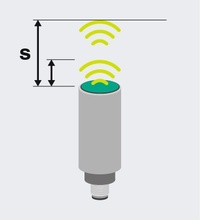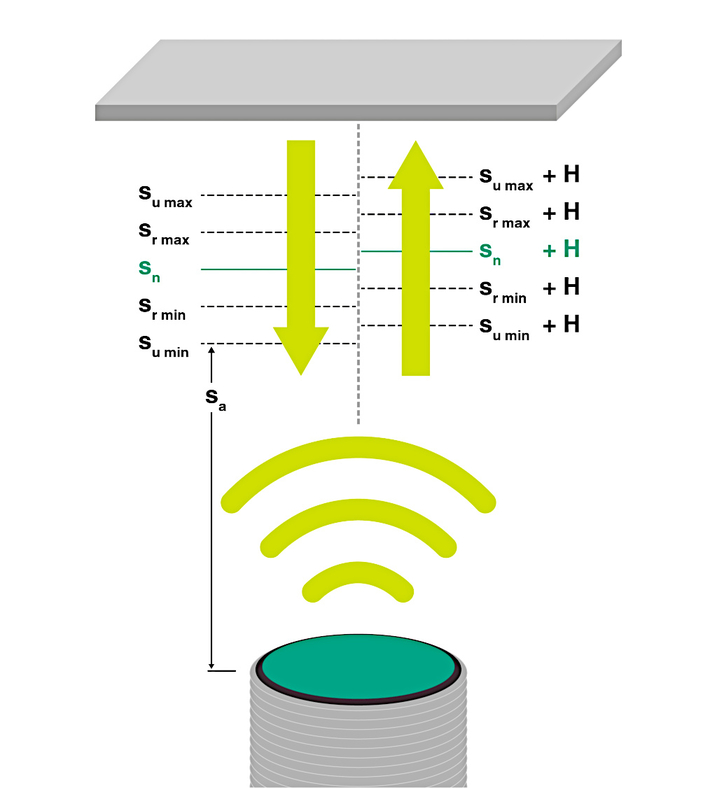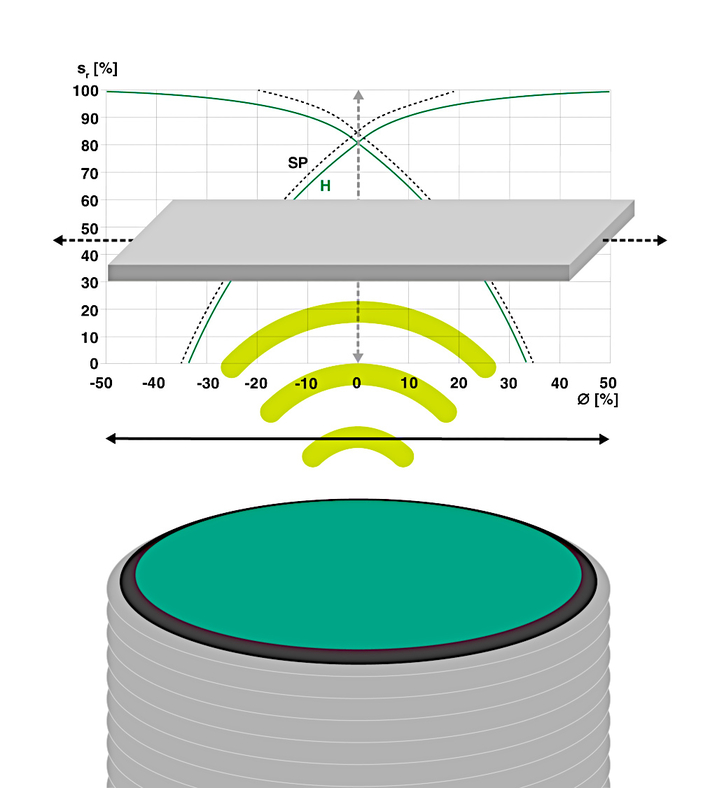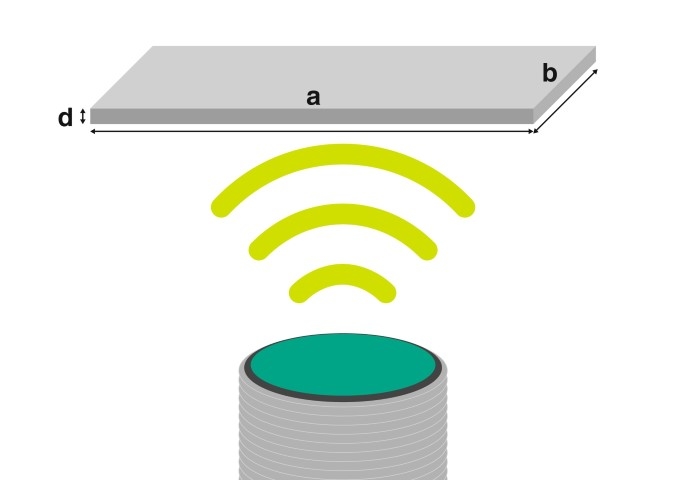Operating Distance as Central Characteristic

A capacitive sensor switches as of a certain distance to a material being detected. This distance is referred to as the "operating distance." The operating distance is the most important characteristic of a capacitive sensor. The operating distance depends on the diameter of the sensor electrode. The dimensions and material composition of the damping element and the ambient temperature are additional influencing factors.
Definition of Operating Distance (s)
EN 60947-5-2 defines the operating distance (s) for all types of sensor other than slot-shaped and ring-shaped designs. By "operating distance" the standard means the "distance at which a signal change at the output is caused by the approach of the 'standard target' to the sensing face along the reference axis."
There are two ways to actuate a sensor:
- Using an axial approach
- Using a radial approach
The operating distance s of a capacitive sensor is based on a grounded metal object of a certain size. In comparison, the change in capacitance is smaller for nonconductive materials or non-grounded conductive materials. The object must therefore be moved closer to the sensor electrode to operate the switch. The actual operating distance depends on the following factors:
- Sensing face of the sensor electrode
- Size and grounding status of the object being detected
- Material (permittivity) of the object being detected
- Sensor installation condition
The lower the permittivity number of the respective material in otherwise comparable geometric installation conditions, the smaller the achievable operating distance s. For most capacitive sensors, the sensitivity can be set within limits using a potentiometer at the sensor. The factory-set, default operating distance can thus still be adapted to the object material and the sensor installation situation.
Determining Operating Distances with a Grounded Standard Target
The standard target is defined as an "optimal actuator element" (~damping element) for operation. A reduction in the dimensions or change in material composition reduces the operating distance.
The standard target specifies some sensor characteristics such as the operating distance or the switching frequency and makes the sensor specifications comparable. The sensor specifications can be used if the damping element used in the actual application corresponds in material and dimensions to the standard target. If the damping element actually used is larger, this does not usually increase the operating distance. If the damping element used is smaller than the standard target specified in the EN 60947-5-2 standard or consists of a different material, this reduces the operating distance. Accordingly, the arrangement of the sensor and damping element must be adjusted on an individual basis such that the reduced operating distance is considered.
Actuation by Axial Approach
For axial actuation of the sensor, the following operating distances are determined using a standard target.

The standard target is square with a thickness of 1 mm and is made of steel, type FE 360 (ST37) with a smooth surface.
The target has one of the following side lengths:
- 1 x inner circle diameter of the sensing face
- 3 x sn
The larger value (i.e. the larger area) applies in all cases.
Example 1
Sensor M18
Operating distance 5 mm
3 x operating distance = 15 mm < sensor diameter
- The damping element must therefore be 18 x 18 x 1 mm.
Example 2
Sensor M18
Operating distance 8 mm
3 x operating distance = 24 mm > sensor diameter
- The damping element must therefore be 24 x 24 x 1 mm.
Operating Distance ("Rated Operating Distance") sn
The operating distance sn, or according to EN 60947-2-5 "rated operating distance," is a conventional variable for determining the operating distance. This type of operating distance does not take into account manufacturing tolerances or changes caused by external influences such as voltage and temperature.
Effective Operating Distance sr
The effective operating distance sr is the operating distance of a single sensor measured under the following conditions:
- Ambient temperature of +23 ± 5 °C
- Voltage within the operating voltage range
- Within the specified installation conditions
0.9 · sn ≤ sr ≤ 1.1 · sn
Usable Operating Distance su
The usable operating distance su is the operating distance of a single sensor measured under the following conditions:
- Ambient temperature range between -25 °C … +70 C
- Supply voltage between 85 % … 110 % of the rated operating voltage
0.9 · sr ≤ su ≤ 1.1 · sr
Assured Operating Distance sa
The assured operating distance sa is the distance from the sensing face, within which actuation of the sensor is assured under set conditions:
0 < sa ≤ 0.81 · sn
Repeat Accuracy R
The repeat accuracy R is the change in the effective operating distance sr, measured under the following conditions:
- Period: 8 hours
- Housing temperature: +23 °C ± 5 °C
- Relative humidity: any
- Supply voltage: Ue ± 5 %; or voltage: any ± 5 % within the rated operating voltage range
R ≤ 0.1 ·sr
Hysteresis H
The hysteresis H is the distance between the switch points (SP) when the standard target approaches the sensor and moves away from it again. The hysteresis is specified relative to the effective operating distance sr. This distance is measured at an ambient temperature of +23 °C ± 5 °C and at the rated operating voltage.
H ≤ 0.2 · sr
The typical hysteresis of Pepperl+Fuchs capacitive sensors is in the range between 5 % … 10 % of the effective operating distance sr.
"Safely Switched Off" State
A sensor is safely switched off if the distance of the standard target to the sensing face is at least three times the operating distance sn .
Actuation by Radial Approach
In addition to axial approach of the standard target, there is radial (lateral) approach. If the standard target is moved laterally into the area of the sensor sensing face, the result is a different operating distance (s) with a different switch point (SP) and correspondingly different hysteresis (H). This depends on the axial distance. This relationship is described by the response curve.

The sensor switches at an axial distance of 0 at approximately 15 % coverage of the active face. At 0.5 * effective operating distance (sr), the sensor surface must already be covered by approximately 35 %. At an axial distance of 0.8 * sr, coverage must be 50 %. At 1* sr, the sensor must be completely covered for it to switch.
Damping Elements in Applications
Size and material in real applications usually deviate from the normative specifications for the standard target. In practice, of course, damping elements that have different dimensions and consist of different materials than the standard target are used. The two factors can be taken into account accordingly.
Size Deviates from Standard Target
Capacitive sensors are often used to query machine parts. Such machine parts rarely have the same size and shape as the standard target to which the technical data of a sensor refers. The operating distance in particular depends on the size of the metal used to damp the sensor. Generally, the operating distance does not increase further if the objects are larger than specified by the standard target. However, if the objects become smaller than the standard target, the operating distance suffers a noticeable decrease. If the object being queried is different in size to the standard target, we recommend checking the operating distance of the selected sensor.

Possible Deviating Variables.
The object area a * b is smaller than the standard target
► the sensing range becomes smaller
The object area a * b is larger than the standard target
► no effect
Material Deviating from the Standard Target
Reduction Factor
In addition to dimensions, the material composition of the damping element plays a particularly important role. This is described by the reduction factor. The reduction factor indicates the factor by which the operating distance for inductive sensors differs from steel FE 360 (St37) due to different materials.
The smaller the reduction factor, the smaller the operating distance for the specific material. Since this reduction factor in the capacitive proximity sensor depends on factors such as the housing and shielding material, it can vary from type to type. The individual value is crucial for each respective sensor.
Material Constants and Operating Distances
The operating distance sn of a capacitive sensor is preset at the factory using a grounded metal object of a certain size under defined installation conditions (flush, nonflush). The preset operating distance is reduced for objects with deviating materials that are to be detected under identical conditions.
Note: If the metal object is not grounded, the size of the metal object becomes the crucial factor that decides whether the metal is detected.
The following table provides an overview of the sizes of material-dependent dielectric constants and expected reduction factors to the rated operating distance.
| Material | Dielectric count r | Reduction factor |
|---|---|---|
| Grounded standard Steel FE 360 (St37) applies to all metals | > 100 … 10 000 | 1 |
| Water | 80 | 1 |
| Alcohol | 22 | 0.75 |
| Glass | 5 … 16 | 0.6 |
| Ceramic | 4 … 7 | 0.5 |
| PVC | 2.3 … 3.4 | 0.45 |
| Wood (dry) | 3 … 7 | 0.3 |
| Oil | 2.6 … 2.9 | 0.28 |
| Paper (dry) | 1.6 … 2.6 | 0.25 |
| Air | 1 | 0 |
Source: Pepperl+Fuchs








 +886 2 27227708
+886 2 27227708